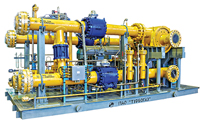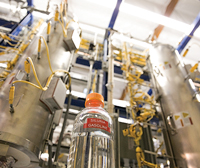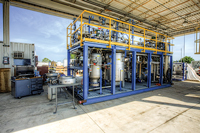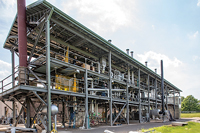Gas processing news
M. Cruthirds, News Editor
SKF to supply magnetic bearings to Turbogaz

SKF has signed a major contract to supply SKF S2M magnetic bearings to Ukrainian turboexpander manufacturer Turbogaz, helping improve reliability and sustainability for the gas industry. Nine sets of bearings, incorporating a standard electronic control cabinet, will be supplied to Uzbekistan, the largest producer and consumer of natural gas in Central Asia.
In turboexpanders—i.e., turbines through which high-pressure gas is used to separate heavier fractions and drive a compressor—bearings are constantly in direct contact with gas, and the harsh environment can accelerate wear and failure.
To meet this challenge, the company’s magnetic bearings offer an oil-free solution for high-speed natural gas turboexpanders, enabling Turbogaz to offer units that are low in maintenance needs. This is vital for the Uzbekistan contract, as the turboexpanders will be installed on remote natural gas treatment plants in the desert, where accessibility for maintenance is costly.
With more than 40 units, Uzbekistan will have one of the largest fleets of turboexpanders operating on SKF S2M Magnetic Bearings. Photo courtesy of SKF.
Gas turbine market to exceed $29 B in 2014
More than $29 billion (B) will be spent for gas turbine and combined-cycle systems by power plants, refineries, oil and gas producers, and other industries this year, according to a forecast by McIlvaine Co.
The expenditure for repairs and replacements will also be sizable. Over $400 million will be spent for replacement filters for the turbine air intakes. Over $1 B will be paid for replacement parts and the complete replacements of pumps and valves.
The amount spent for catalyst and for ammonia to reduce NOx emissions will be substantial, and it is anticipated to grow significantly, as most new units are required to meet stringent air emissions limits. The investment for treatment chemicals is also increasing, as most of the new units are using steam turbines in combined-cycle operation.
BP awards work for Khazzan tight gas
Jacobs Engineering Group was awarded a contract by BP for process and infrastructure work on the greenfield Khazzan project in Oman. Under the terms of the contract, Jacobs is providing engineering, procurement and construction management services in relation to approximately $2 B of gas gathering and water pipelines, wellhead production facilities and export pipelines for the development of the southern sector of Block 61.
Jacobs’ scope of work also includes detailed design and program management for the associated project infrastructure. The work uses resources from multiple Jacobs offices in the Middle East, the UK, India and the US. Additionally, Jacobs will utilize local workers and
suppliers in Oman.
In December 2013, the Omani government and BP announced a gas sales agreement and an amended production-sharing agreement for the development of the Khazzan field, with BP as operator. The Khazzan project represents the first phase in the development of one of the Middle East’s largest unconventional tight gas accumulations.
API awards safety honors to BP
BP’s US pipeline business was recognized in April for industry-leading safety and environmental performance in 2013 by the American Petroleum Institute (API) at its annual pipeline conference. Don Porter, who leads BP’s US pipelines business, accepted API’s Occupational Safety and Environmental Performance award in the large-operator category on behalf of the company.
BP earned both awards by logging the best worker safety and liquids handling performance statistics among all pipeline entrants last year. In 2013, BP’s US pipeline employees and contractors worked 5.7 million (MM) hours without an OSHA recordable incident, achieving a recordable incident frequency rate of zero.
Since February 2012, BP’s US pipelines business has logged more than 13 MM work hours without recording an incident causing a worker to miss work due to an injury.
BP was also the top environmental performer, based on the two metrics used in the judging: the number of releases per mile (mi) of liquid pipeline operated, and the volume released per barrel-mi of liquid transported.
BP’s 3,705-mi US pipeline network recorded only five spills of more than 5 gal in 2013, for a rate of 0.00135 incidents/mi. This rate equated to a total released volume of 3.2 ounces released for every 100,000 bbl transported.
Siluria technology converts gas into liquid fuels

Siluria Technologies has unveiled a first-of-its-kind development unit for producing liquid fuels from natural gas, based on its proprietary oxidative coupling of methane (OCM) and ethylene-to-liquid (ETL) technologies. The announcement was made during a ceremony in mid-March at Siluria’s new facility in Hayward, California, which began operations in November 2013.
Siluria’s OCM and ETL technologies form a process for transforming methane—the principal ingredient in natural gas and renewable methane—into gasoline, diesel, jet fuel and other liquid fuels. Unlike many of the high-temperature, high-pressure cracking processes used to produce fuels and chemicals, the company’s process employs catalytic processes to create longer-chain, higher-value materials, thereby lowering operating costs and capital.
Earlier this year, Siluria announced that it will build an OCM demonstration plant at Braskem’s site in La Porte, Texas. Siluria and Braskem have also entered into a relationship to explore commercialization of this technology. The OCM demonstration plant will begin operations later this year.
FW wins Kuwait LNG contract
Foster Wheeler (FW) has been awarded the pre-front-end engineering design (pre-FEED) and the FEED contract by Kuwait National Petroleum Co. (KNPC) for a new onshore LNG import and regasification terminal to be built in Kuwait.
FW previously completed conceptual and detailed feasibility studies for the terminal, to assist in the selection of the most suitable technology and location for the new terminal.
The new terminal will have a design sendout capacity of approximately 1,500 MMscfd of gas, with four full-containment LNG storage tanks, each with a capacity of 180,000 cm. The design will also allow for future expansion up to 3,000 MMscfd, and the installation of an additional four LNG storage tanks of the same capacity as the initial tanks.
FW will work with a local partner in executing the project, which is scheduled to be completed in October 2014. KNPC plans to start commercial operation of the terminal in 2020.
GTL venture eyes landfill gas, biogas

Velocys has entered a joint venture (JV) with Waste Management, NRG Energy and Ventech Engineers to develop gas-to-liquids (GTL) plants in the US and other select geographies.
The JV will pursue the development of multiple plants, using a combination of renewable biogas (including landfill gas) and natural gas. Waste Management intends to supply renewable gas and, in certain cases, project sites.
All four members will work exclusively through the JV to pursue the intended application (GTL using renewable gas, optionally in conjunction with natural gas) in the US, Canada, the UK and China.
As its first commercial facility, the JV is targeting a plant to be located at Waste Management’s East Oak landfill site in Oklahoma. Detailed engineering for this first project is being completed, while final draft permitting documents for the facility have been submitted.
The JV intends to make a final decision this year to proceed on the first plant. Development activities for additional facilities are expected to commence shortly. Photo courtesy of Velocys.
Magnolia LNG to export to FTA countries
The US Department of Energy (DOE) has granted authorization for Magnolia LNG LLC to export an additional 4 MMtpy of LNG from its proposed project site at the Port of Lake Charles, Louisiana. The authorization follows the DOE’s initial approval, which was granted in February 2013, to export up to 4 MMtpy of LNG to Free Trade Agreement (FTA) countries.
The authorization is valid for first LNG sales to commence within 10 years, and then for a period of 25 years from first LNG sales. LNG sales are permitted to all existing, and any future, countries that have, or enter into, an FTA with the US.
Atlas expands Permian processing, Pioneer contract
Atlas Pipeline Partners (APL) announced that Atlas Pipeline and Pioneer Natural Resources have entered into an agreement to substantially expand Pioneer’s commitment to APL in the Permian basin of West Texas.
The amendment extends the contractual term for an additional 10 years (through 2032), and it extends the area of mutual interest in Martin and Andrews counties in the rapidly developing northern part of the basin.
Responding to the accelerating pace of activity in this portion of the play, APL will immediately undertake the construction of a new, 200-MMcfd cryogenic processing facility in the northern part of the Permian basin. The facility is scheduled to enter service in the second half of 2015. The Pioneer extension is under similar terms as the existing contract.
This plant will be fully integrated with APL’s WestTX gathering and processing system, which has 455 MMcfd of processing capacity and
over 3,600 mi of gathering infrastructure.
The new processing capacity comes on the heels of the Edward facility, another 200-MMcfd cryogenic plant that was announced in July 2013 and which is expected to be in service early in the fourth quarter of 2014.
Upon completion of these additions, APL will have 855 MMcfd of processing capacity in the Permian basin. Construction and installation costs for the plant are expected to be $100 MM to $120 MM, net to APL. The majority of the capital will be invested in 2015.
Williams assesses Opal fire damage
Williams Partners is deploying safety measures and performing an initial assessment of damage in a small area of one of the five plants on its 160-acre Opal, Wyoming gas processing facility, which was affected by a fire in late April.
In coordination with regulatory agencies, the company is assessing damage and developing preliminary plans to bring the other four plants back into service in a safe, systematic and timely manner. The capacity of the four undamaged plants totals 1.1 Bcfd, which is sufficient to handle all of the natural gas available to the facility.
The facility has been shut down since the incident occurred on the afternoon of April 23. There were no reported injuries or damage to property outside the facility. The plant’s emergency procedures performed as designed.
The Opal gas processing plant has a capacity to process 1.5 Bcfd of natural gas via five turboexpander cryogenic gas processing units. Although the company has not yet made a full assessment of all plant equipment, the initial visual assessment of damage indicated that the impact was largely limited to a small area of the TXP-3 unit. At the time of the incident, it was one of the four units running to handle recent inlet volumes of approximately 1 Bcfd of natural gas. The fifth unit was idle, serving as excess capacity for the facility.
Information from the company’s visual inspection of the damage area indicated that there was a release of natural gas that was subsequently ignited. The focus of the investigation will be on the cause of the release and the source of the ignition.
Canada approves Triton LNG exports

Canada’s National Energy Board (NEB) approved an application for a 25-year natural gas export license from Triton LNG to export LNG.
The proposed export points would be located near either Kitimat (pictured) or Prince Rupert, British Columbia, at the outlet of the loading arm of a proposed LNG terminal. The liquefaction terminal has not been constructed, and it will require additional regulatory approval before work can begin.
When evaluating natural gas and LNG export license applications, the NEB examines whether the quantity of gas proposed for export is surplus to Canadian requirements, while taking into account trends in the discovery of gas in Canada. Each application is assessed on its own merits.
In this case, the NEB determined that the quantity of gas proposed to be exported is surplus to Canadian requirements. Additionally, the NEB said it is satisfied that the gas resource base in Canada, as well as in North America, is large and can accommodate reasonably foreseeable Canadian demand, along with the Triton LNG export application and a potential increase in demand. Photo courtesy of LNG Canada.
Study: Canada could benefit from marine LNG
A recent report highlighted the benefits of using LNG as an affordable, lower-emissions fuel for Canada’s marine sector. According to the report, “Liquefied natural gas: A marine fuel for Canada’s West Coast,” all of the technologies needed to use LNG as a marine fuel are proven and commercially available.
In the near term, coastal vessel operators have the best opportunity to benefit from LNG, according to the study. For six coastal vessels analyzed, fuel costs were reduced by more than 50%, with five of the ships having a payback on initial investment in less than six years.
The marine sector can also serve as an important new market for British Columbia’s extensive natural gas resources. Under a “medium” LNG adoption scenario, 150 LNG vessels operating on the West Coast by 2025 would create new demand equal to 8.5% of British Columbia’s 2012 natural gas use.
New marine regulations, taking effect in January 2015, require a 90% reduction in fuel sulfur content. Compared to traditional marine fuels, LNG use can reduce sulfur emissions by at least 90%, cut NOx emissions by 35% or more, decrease particulate matter by at least 85%, and reduce greenhouse gas (GHG) emissions by up to 19%.
Jointly funded by Transport Canada and a broad group of industry and other participants, the report recommends changes to Canada’s marine regulatory framework to allow for the review and approval of new LNG projects. These changes would support new projects moving forward, including the use of three LNG ferries planned for operation in 2017.
Black & Veatch technology helps China air quality
Langzhong Shuangrui (Meifeng) has selected the Black & Veatch-Chemtex team to design and build a new LNG facility in Langzhong, China. The facility will produce 35 million standard cubic feet per day (MMscfd) of LNG, and it is based on Black & Veatch’s patented PRICO technology. LNG from the plant will be used to provide fuel for vehicles and to spur economic growth in the region. The project is expected to be completed in 2016.
A push for smog-free air is spearheading China’s role as one of the biggest players in the global trade for LNG. In an effort to curb pollution, the Chinese government is seeking to reduce its reliance on coal, and it is turning to natural gas as a reliable alternative to generate electricity. China is the third-largest importer of LNG, and it consumes 6% of the global LNG trade. In 2012, China imported 706 Bcf, a 20% increase from 581 Bcf in 2011.
SIBUR approves gas processing expansion
Russia’s SIBUR has approved the Vyngapurovsky gas processing plant expansion project to launch the processing of associated petroleum gas (APG) from Russneft’s fields. New facilities to be built at the plant will increase APG processing capacity from 2.8 Bcmy to 4.2 Bcmy.
A 100-km pipeline will be laid to transport APG from Russneft’s Varieganskaya compressor station to the Vyngapurovsky processing plant. The compressor station will also undergo renovation.
Russneft is an existing APG supplier to SIBUR’s Nizhnevartovskiy and Belozerniy gas processing plants. In 2013, SIBUR and Russneft signed a new long-term agreement for APG supplies to 2025.
The Vyngapurovsky plant, with a designed capacity of 2.8 Bcmy of APG, was built by SIBUR on the grounds of the compressor station of the same name, and it was commissioned in September 2012. At present, the major APG supplier to the Vyngapurovsky plant is Gazprom Neft.
Primus conducts second GTL demo plant run

In the fourth quarter of 2013, Primus Green Energy successfully completed 720 hours of continuous run at its 100,000-gallons-per-year GTL demonstration plant. Following plant operations, an independent engineer’s report, prepared by E3 Consulting, concluded that Primus’ STG+ technology exceeded initial expectations.
In the second quarter of 2014, the company started a second continuous demonstration plant run at its Hillsborough, New Jersey headquarters, which was expected to run through the end of May. With this run, the company aimed to further improve the plant’s production capacity, optimize operation variables and continue accumulating operating hours on the catalysts.
The demonstration plant, which utilizes Primus’ proprietary STG+ technology, was formally commissioned in October 2013, making it one of the first advanced alternative fuel plants in operation that produces gasoline from natural gas. Primus Green Energy plans to break ground on its first commercial plant later in 2014. Photo courtesy of Primus Green Energy.
Enterprise wins permit for PDH unit
The US Environmental Protection Agency (EPA) recently issued a final greenhouse gas (GHG) Prevention of Significant Deterioration construction permit for the Enterprise Products operating facility in Mont Belvieu, Texas.
The permit allows the company to build a propane dehydrogenation (PDH) unit with catalytic reactors, heaters and gas turbines that maximize thermal efficiency. The project will use catalytic reactors to convert propane into propylene and hydrogen. The project is also expected to produce over 1.6 B lb/yr of propylene.
In June 2010, the EPA finalized national GHG regulations which specify that, beginning on January 2, 2011, projects that substantially increase GHG emissions will require an air permit.
Texas is working to replace a federal implementation plan with its own state program, which will eliminate the need for businesses to seek air permits from the EPA. This action is designed to increase efficiency and allow for industry to continue growing in Texas, according to EPA officials.
The EPA has finalized 35 GHG permits in Texas, proposed an additional nine permits, and has over 30 additional GHG permit applications under review in the state.
Shell creates motor oil from natural gas

Shell has announced the creation of the first-of-its kind base oil made from natural gas. Shell PurePlus Technology is a patented process of converting natural gas into clear base oil, which is the main component of motor oils. The technology is now being used to create oils for motorists in the US.
Shell PurePlus Technology base oil is manufactured at the Pearl GTL facility in Ras Laffan in Qatar, a partnership between Qatar Petroleum and Shell. Photo courtesy of Shell.
Cameron LNG awards contracts for export facilities
CB&I and Chiyoda have been awarded a contract valued at approximately $6 B by Cameron LNG to construct the Cameron liquefaction project in Hackberry, Louisiana. The scope of work includes engineering, procurement and construction for the addition of natural gas liquefaction and export facilities to the existing LNG regasification facility.
The Cameron LNG project comprises three liquefaction trains with a nameplate capacity of approximately 13.5 MMtpy of LNG. In February 2014, Cameron received conditional authorization from the US Department of Energy (DOE) to export domestically produced
LNG to countries that do not have a free trade agreement (FTA)
with the US, including those in Europe and Asia.
Subject to a final investment decision, finalization of permits and the securing of financing, Sempra Energy will have an indirect 50.2% ownership interest in Cameron and the related liquefaction project. The remaining portion of Cameron and the related liquefaction project will be owned by affiliates of GDF SUEZ, Mitsubishi (through a related company jointly established with Nippon Yusen Kabushiki Kaisha) and Mitsui, each with 16.6% stakes.
Williams to expand Transco pipeline
Williams Partners LP and its wholly owned subsidiary, Transcontinental Gas Pipe Line Co. LLC, have announced Gulf Trace, a 1.2-MM-dekatherm-per-day expansion of the Transco pipeline system to serve Cheniere Energy Partners LP’s Sabine Pass liquefaction project being developed in Cameron Parish, Louisiana. The Sabine Pass LNG terminal will connect US natural gas supplies with global LNG markets.
Transco has executed an agreement with Sabine Pass Liquefaction LLC as the anchor shipper, which provides a transportation contract quantity that is sufficient to proceed with execution of the Gulf Trace project. A binding open season to gauge additional market interest in the expansion was scheduled to conclude on May 8.
The Sabine Pass LNG export facilities are currently under construction. They are scheduled to be completed in phases, starting as early as the fourth quarter of 2015. Once complete, the Sabine Pass LNG terminal will be the first large-scale LNG export facility in operation in the US. Sabine Pass Liquefaction’s project is supported by long-term contracts with several LNG offtake shippers, and it is expected to provide LNG for export to diverse markets overseas.
The Gulf Trace project will make Transco’s production-area mainline and southwest Louisiana lateral systems bidirectional from Station 65 in St. Helena Parish, Louisiana to Cameron Parish, Louisiana. In addition to the pipeline reversal, a new, 8-mi, 36-in. lateral pipeline and two new compressor stations are planned to provide transportation service to the Sabine Pass LNG facility.
The estimated project cost for Gulf Trace is approximately $300 MM, and the target in-service date is early 2017.
US renews ConocoPhillips’ Kenai LNG permit
The US Department of Energy (DOE) has renewed ConocoPhillips’ permit to export LNG from Alaska to all countries. With the latest permit, ConocoPhillips is allowed to export up to 40 Bcf of LNG from Alaska’s Kenai terminal over the next two years.
ConocoPhillips’ previous permit for the terminal lapsed in March 2013, amid concerns about falling gas production in the Cook Inlet region. However, last September, Alaska’s Department of Natural Resources asked ConocoPhillips to resume LNG exports, thereby supporting local gas production and providing supply security in the region.
“[The] announcement by DOE...highlights the growth that’s occurring in Cook Inlet, where there is now ample gas supply to both meet local needs and help out our friends overseas,” said Senator Lisa Murkowski of Alaska, the top Republican on the Senate energy committee.
Japan has historically been the main buyer of Alaskan LNG. Unlike other gas export proposals around the US, Alaskan gas exports are not usually controversial because the state’s geographic isolation means that most of its gas is already sent to other countries.
Toyo Engineering wins India work orders
Toyo Engineering has been awarded a regasification plant project by Petronet LNG in India, the company confirmed. The plant is to be constructed at Dahej, in the state of Gujarat on the west coast of India, to expand LNG receiving capacity from 10 MMtpy to 15 MMtpy.
Toyo India will lead engineering, procurement and construction (EPC) work on a turnkey basis, from engineering to construction and commissioning. The plant is scheduled to be completed at the beginning of 2017.
The company was also awarded a project for a new regasification plant with a sendout capacity of 5 MMt. The plant is to be constructed by GSPC LNG Ltd. (GLL) in Mundra, Gujarat. Once again, Toyo India will lead EPC work on a turnkey basis, from engineering to construction and commissioning. The plant is scheduled to be completed by the end of 2016.
GLL is a joint venture mainly anchored by Gujarat State Petroleum Corp., which is involved in the exploration and production of oil and gas. The venture aims to establish an LNG receiving, storage and regasification terminal.
US DOE authorizes Jordan Cove LNG exports
The US Department of Energy (DOE) has conditionally authorized Jordan Cove Energy Project LP to export domestically produced LNG to countries that do not have a Free Trade Agreement (FTA) with the US, from the Jordan Cove LNG terminal in Coos Bay, Oregon.
The Jordan Cove application was next in the order of precedence after the DOE conditionally authorized the proposed Cameron LNG facility. Subject to environmental review and final regulatory approval, the Jordan Cove facility is conditionally authorized to export at a rate of up to the equivalent of 0.8 Bcfd of natural gas, for a period of 20 years.
The development of US natural gas resources is having a transformative impact on the US energy landscape, helping improve the nation’s energy security while spurring economic development and job creation around the country.
This increase in domestic gas production is expected to continue, with the US Energy Information Administration forecasting record production of 72.02 Bcfd in 2014.
Linde to build H2 unit in Finland
The Linde Group and Neste Oil have agreed on a long-term, onsite hydrogen (H2) supply contract. According to the agreement, Linde will build a new H2 production unit for Neste Oil’s Porvoo refinery near Helsinki, Finland. The total investment value from Linde and Neste Oil amounts to approximately $138 MM.
Neste Oil’s Porvoo refinery already has two H2 production units, with the older one now due for replacement by a more efficient unit. Linde’s engineering division will build the turnkey plant, while its northern European subsidiary, AGA, will be responsible for the operation of the new unit that is planned to come onstream in 2016. Neste Oil will build the piping between the new plant and the refinery.
The H2 will be produced from natural gas in a steam reforming process, and it will be used at the Porvoo refinery in many processes and products. H2 is used to produce sulfur-free diesel fuel and high-quality base oils, among other products.
The new contract is an expansion of the two companies’ existing supply relationship at the Porvoo site. Linde already provides Neste Oil with air gases, while obtaining, in return, offgas CO₂ for subsequent purification. GP




Comments